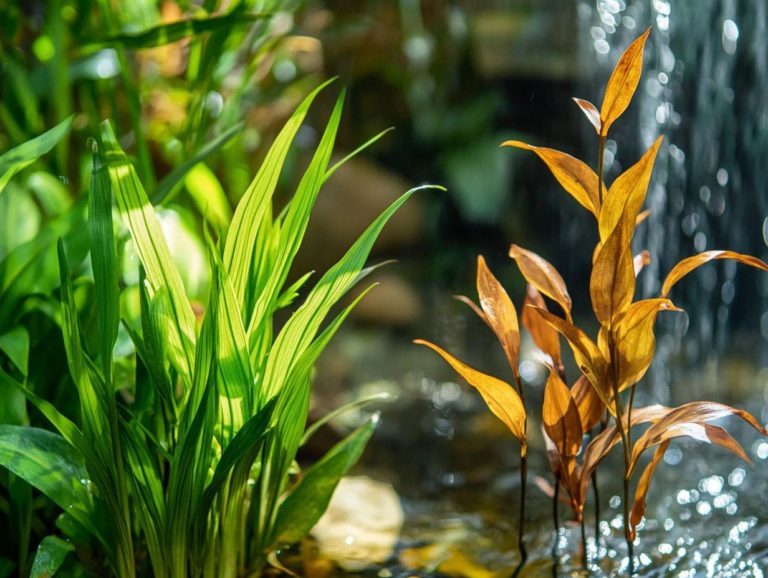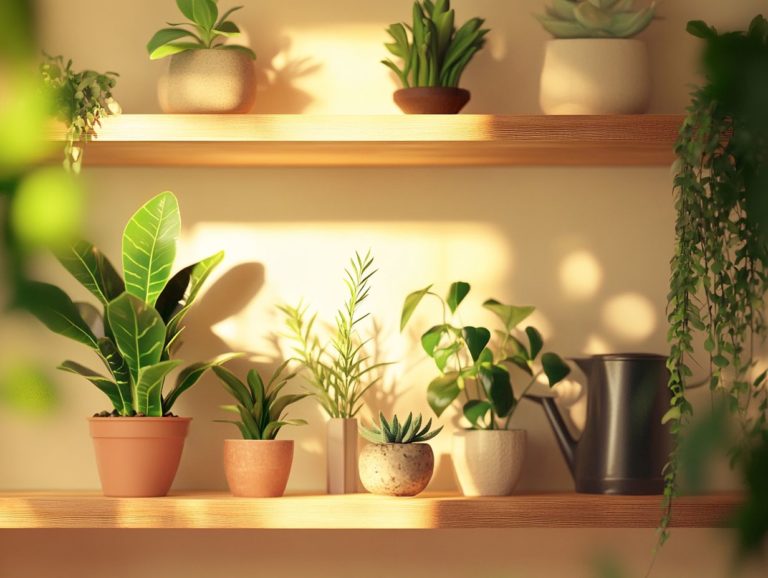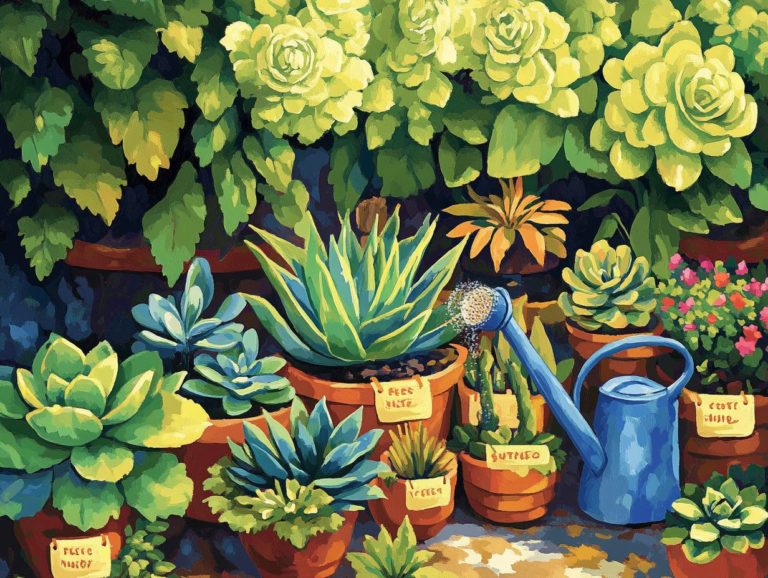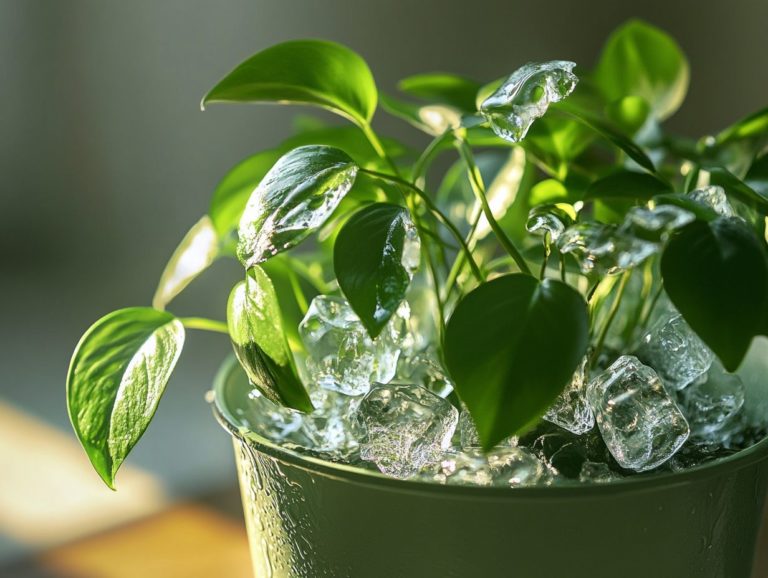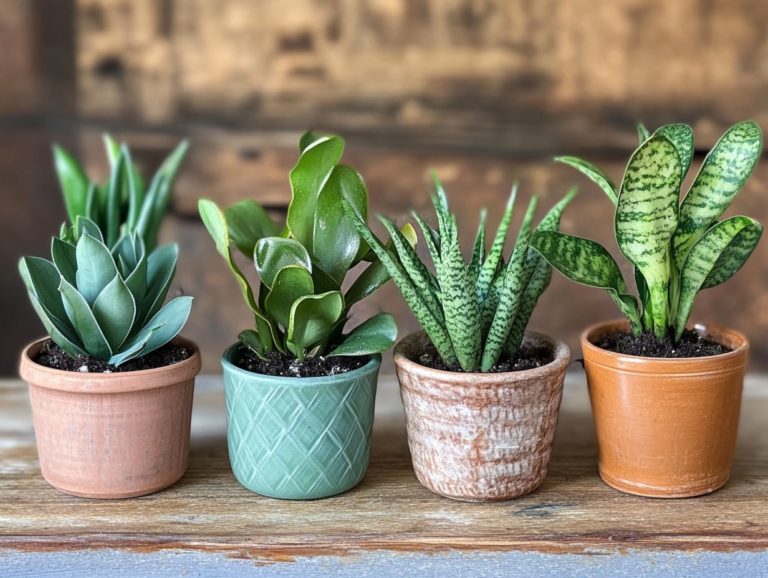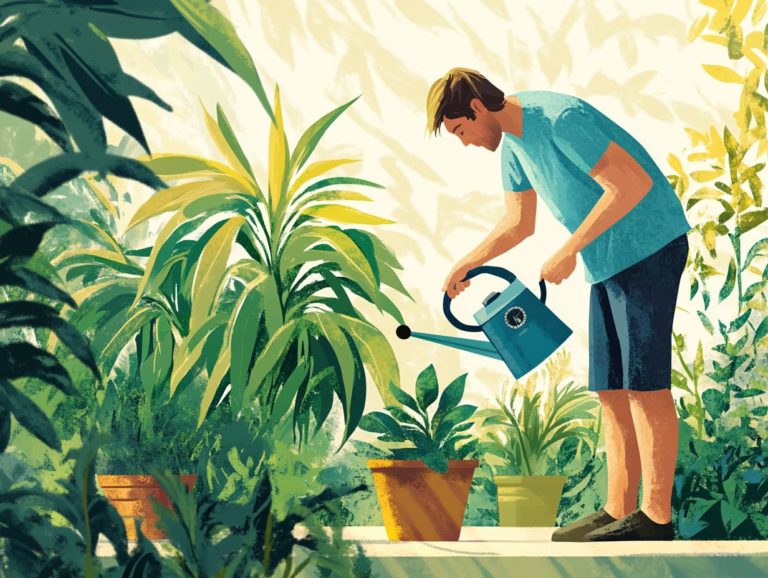5 Watering Myths About Indoor Plants
Indoor plants have the remarkable ability to infuse any space with life and vibrancy, but their thriving largely hinges on proper care particularly when it comes to watering.
Yet, there are several myths that can cloud your understanding of their needs. You might believe that indoor plants require less water than those thriving outdoors or think that all plants adhere to a universal watering schedule. It’s time to clear up these misconceptions.
Join in as you discover the truth behind five common myths and learn how to nurture your indoor greenery, ensuring it remains healthy and flourishing.
Contents
- Key Takeaways:
- 1. Myth #1: Indoor Plants Don’t Need as Much Water as Outdoor Plants
- 2. Myth #2: Watering Once a Week Is Enough for All Indoor Plants
- 3. Myth #3: Watering from the Top Is the Best Way to Water Indoor Plants
- 4. Myth #4: Yellow Leaves Mean Your Plant Needs More Water
- 5. Myth #5: All Indoor Plants Have the Same Watering Needs
- How Much Water Do Indoor Plants Actually Need?
- What Factors Affect the Watering Needs of Indoor Plants?
- How Can You Tell If Your Indoor Plant Needs Water?
- What Are the Consequences of Overwatering or Underwatering Indoor Plants?
- What Are Some Tips for Properly Watering Indoor Plants?
- Are There Any Exceptions to These Watering Myths for Certain Types of Indoor Plants?
- Frequently Asked Questions
- How often should I water my indoor plants?
- Is it better to water indoor plants from the top or bottom?
- Can I use ice cubes to water my indoor plants?
- Should I water my indoor plants with filtered water?
- Do indoor plants need to be watered less in the winter?
- Can I water my indoor plants with leftover coffee or tea?
Key Takeaways:
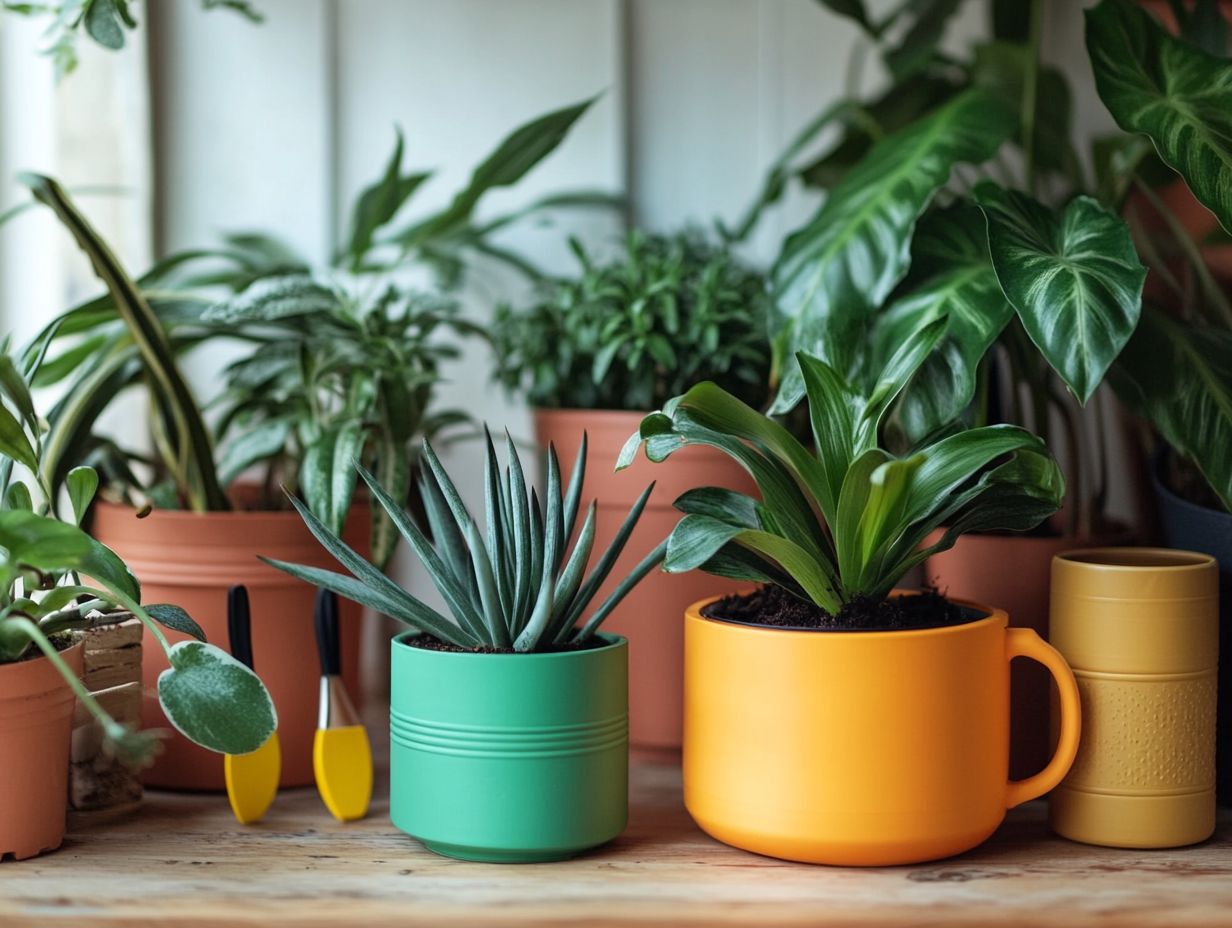
- Indoor plants have different watering needs than outdoor plants. Don’t assume they need less water just because they are inside.
- Watering once a week may not be enough for all indoor plants. Factors such as plant type, size, and environment can affect watering needs.
- Bottom watering is often a more effective approach. Consider using a watering can with a narrow spout to avoid overwatering.
1. Myth #1: Indoor Plants Don’t Need as Much Water as Outdoor Plants
Do you think indoor plants don t need as much water as those thriving outdoors? This common mistake can really set back the growth and health of your houseplants, such as African Violets and ZZ Plants, especially when humidity and moisture levels are all over the place.
While outdoor plants enjoy the benefits of natural rainfall, your indoor varieties depend entirely on your care. African Violets, with their delicate leaves, love humidity but can quickly suffer from overwatering. Experts like Madison Moulton recommend keeping the soil consistently moist yet well-drained.
On the other hand, the resilient ZZ Plant thrives on your occasional neglect, making it the perfect choice if your watering schedule isn t exactly regular.
Key elements such as light exposure and soil drainage are crucial in establishing a proper watering routine, as highlighted by trusted sources like Good Housekeeping. Grasping these nuances will lead you to healthier, more vibrant plants that truly flourish in their homes.
2. Myth #2: Watering Once a Week Is Enough for All Indoor Plants
Are you watering your indoor plants just once a week? This can easily lead to overwatering or underwatering, jeopardizing the health of both tropical plants and succulents. Experts like Arricca Elin SanSone highlight this important distinction.
Tropical plants, which thrive in humid environments, typically require more frequent watering than succulents, which are designed to flourish in arid conditions. Factors such as soil type, drainage systems (ways for excess water to escape), and the specific moisture levels in your plants’ environments can all influence how often and how much you should water.
It s wise to keep an eye on the texture and moisture levels of the soil, and be ready to adjust your watering routine based on seasonal changes and the unique needs of each plant. This customized approach not only fosters robust growth, but it also elevates the overall health of your indoor garden.
3. Myth #3: Watering from the Top Is the Best Way to Water Indoor Plants
Are you watering your plants the right way? Many gardeners might mistakenly think that top watering is the best way to care for indoor plants, but this method can lead to uneven moisture distribution and poor root development, particularly in plants that thrive under specific soil and drainage conditions.
Bottom watering is often a more effective approach. This technique encourages roots to delve deeper in search of moisture, ensuring an even distribution throughout the soil. It can be especially beneficial for particular varieties that flourish with consistent moisture levels, like some tropical plants.
Don t overlook the importance of drainage holes. They play a crucial role in preventing waterlogging and ensuring excess moisture has a way to escape. It s essential to adjust your watering methods based on the types of plants you have; succulent enthusiasts might prefer bottom watering to avoid over-saturation, while those tending to moisture-loving species may opt for a top watering strategy, regularly checking soil dampness to keep everything just right.
Act now to ensure your plants thrive!
4. Myth #4: Yellow Leaves Mean Your Plant Needs More Water
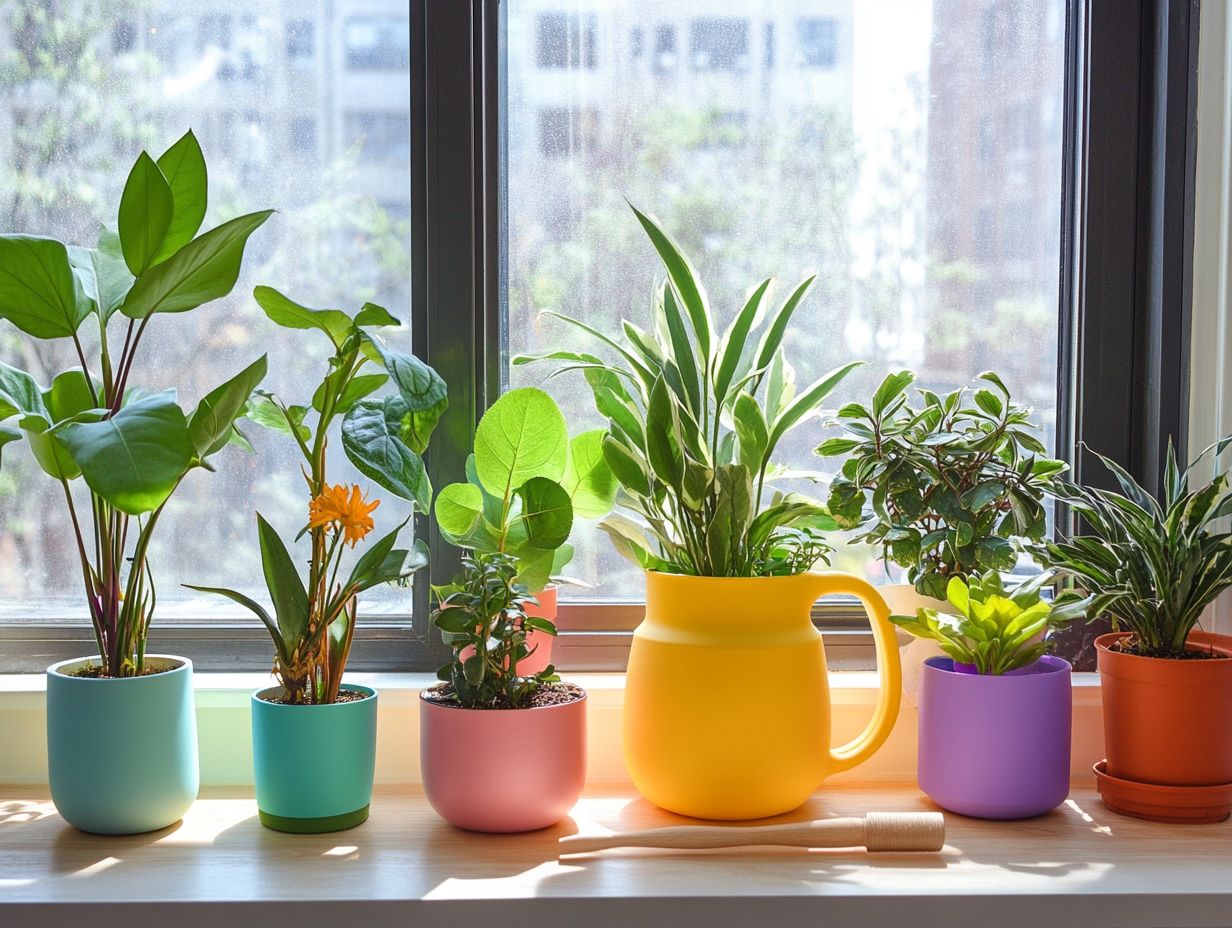
Spotting yellow leaves on your plant might lead you to think it s time for a drink, but that assumption can be misleading. Yellowing leaves can also indicate problems related to light, soil quality, or even diseases affecting indoor plants.
Looking more closely at the underlying factors reveals that inadequate light can cause leaves to yellow as your plant struggles to make food using sunlight. Nutrient deficiencies especially nitrogen can also show up as yellowing foliage, signaling that your plant craves essential elements for robust growth.
Then there’s the tricky issue of overwatering. While it may seem like the obvious villain, it can actually lead to root rot, making the situation worse and worsening the yellowing. Understanding these symptoms is essential for anyone looking to nurture vibrant, healthy houseplants and ensure they thrive in their indoor oasis.
5. Myth #5: All Indoor Plants Have the Same Watering Needs
The notion that all indoor plants have the same watering requirements is a misconception that can lead to improper care. Different species, like tropical plants and succulents, flourish under distinct moisture conditions.
Recognizing these differences is essential for cultivating a thriving indoor garden. Tropical plants, such as ferns and peace lilies, thrive in higher humidity environments. They require more frequent watering and should be placed in areas where the air remains consistently moist.
Succulents and cacti prefer drier conditions and flourish in well-draining soil. They benefit from less frequent, yet thorough, watering sessions. To keep your indoor plants thriving, consider employing a humidity tray for your tropicals or using a well-draining potting mix for your succulents. Additionally, be mindful of the top 7 mistakes in watering indoor plants and adjust your watering schedule to meet the specific needs of each type.
How Much Water Do Indoor Plants Actually Need?
Determining the right amount of water for your indoor plants is essential for promoting their growth and overall health. This can vary significantly based on the type of plant, environmental conditions, and the care practices you employ.
Several factors come into play when assessing watering needs. Light exposure, for instance, can greatly influence how quickly moisture evaporates from the soil. For guidance on choosing the right water for indoor plants, it’s important to note that plants basking in bright light typically require more frequent watering compared to those in shadier spots.
Humidity levels in your home also play a crucial role in soil moisture. Higher humidity can reduce how often you need to water, while drier air may require you to check in on your plants more frequently.
Don’t overlook the type of soil you’re using. Well-draining soil usually dries out faster, while heavier mixtures can retain moisture for longer periods. As a general rule, leafy greens and tropical plants prefer slightly moist soil, while succulents and cacti thrive on a more sparse watering schedule. To ensure you’re using the best methods, check out the best watering techniques for indoor plants.
To gauge moisture levels effectively, you might use the finger test or invest in a moisture meter, a tool to check how wet or dry the soil is. This will empower you to make more informed care decisions for your beloved plants.
What Factors Affect the Watering Needs of Indoor Plants?
Several key factors significantly influence the watering needs of your indoor plants, including the amount of light they receive, the humidity levels in their environment, and the type of soil they are using.
Understanding these elements can help you optimize care and promote thriving greenery. For example, succulents flourish in bright, direct light and can tolerate lower humidity levels, leading to slower evaporation of moisture from their soil. In contrast, tropical plants like ferns thrive in high humidity, allowing for better moisture retention in their soil, which means you ll need to water them less frequently.
The soil composition is also crucial; well-draining mixes are essential for cacti, while richer, moisture-retaining soils benefit plants like peace lilies. This interplay of light, humidity, and soil truly shapes your watering strategies.
Check your plant s soil moisture today to keep your indoor oasis vibrant and healthy!
How Can You Tell If Your Indoor Plant Needs Water?
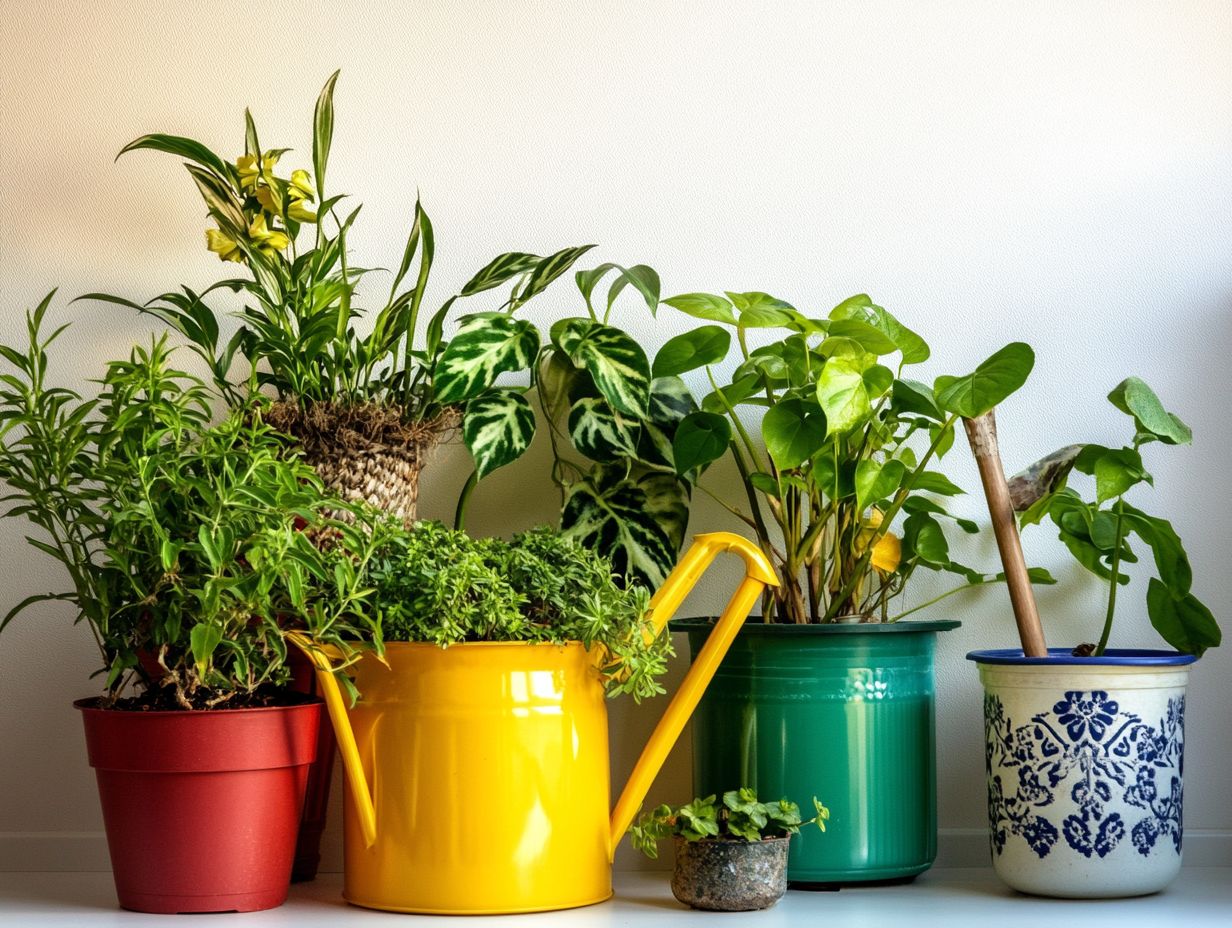
Recognizing when your indoor plant needs water is crucial for its well-being. You can often determine this by keenly observing the leaves and checking the soil moisture.
Understanding the specific needs of each plant species is also important. A classic sign that your plant might be thirsty is drooping leaves, which indicate that it’s struggling to maintain its water pressure. You might also notice a dry top layer of soil, signaling that moisture has been depleted.
For a more precise assessment, consider sticking your finger about an inch into the soil. If it feels dry, it’s definitely time to water.
It’s important to learn the specific needs of each plant, as light and humidity affect watering. By familiarizing yourself with these signs, you ll elevate your plant care routine and help your greenery flourish.
What Are the Consequences of Overwatering or Underwatering Indoor Plants?
Both overwatering and underwatering can wreak havoc on your indoor plants, potentially leading to diseases, stunted growth, or even death if not addressed swiftly and correctly.
Overwatering can result in root rot, where the roots turn mushy and brown, leaving your plant unable to absorb nutrients effectively. You might notice signs like yellowing leaves and a foul odor from the soil.
Conversely, underwatering often manifests as wilting, with drooping leaves and parched soil. This makes it a struggle for your plant to thrive.
You must establish a consistent watering schedule and routinely check soil moisture levels. If root rot strikes, repotting the plant in fresh, dry soil and trimming away affected roots can salvage it.
If you suspect underwatering, a thorough soak will instantly rejuvenate your plant’s vitality!
What Are Some Tips for Properly Watering Indoor Plants?
To ensure the health and vitality of your indoor plants, implementing proper watering techniques is essential. Focus on soil quality, ability to hold moisture, and good drainage.
Recognizing that not all plants share the same watering needs is crucial. Factors such as pot size, plant type, and environmental conditions can significantly influence moisture levels.
Employing tools like moisture meters can provide valuable insights on when to water. A watering can with a narrow spout allows for precise application, helping to prevent overwatering.
Regularly inspect the drainage holes in your pots. If water accumulates, you may be inviting root rot. Adjusting your watering routine according to seasonal changes and indoor humidity levels will also support optimal growth for your cherished greenery.
Are There Any Exceptions to These Watering Myths for Certain Types of Indoor Plants?
While many watering myths float around, there are notable exceptions for certain indoor plants, especially tropical varieties and succulents, which demand unique care strategies.
Tropical plants, for instance, thrive in consistently moist conditions, relishing rich, well-draining soil that holds humidity without becoming waterlogged. Their lush foliage means they typically need more frequent watering, particularly during the warm months when their growth accelerates.
In contrast, succulents have mastered the art of water storage within their leaves and stems, making them champions of drought resilience.
This means their watering routine is decidedly less demanding; overwatering can swiftly lead to root rot. It s wise to check the soil moisture before watering succulents, as they prefer a dry spell between drinks to truly flourish.
Understanding these specific needs will help you nurture healthier, vibrant plants.
Frequently Asked Questions
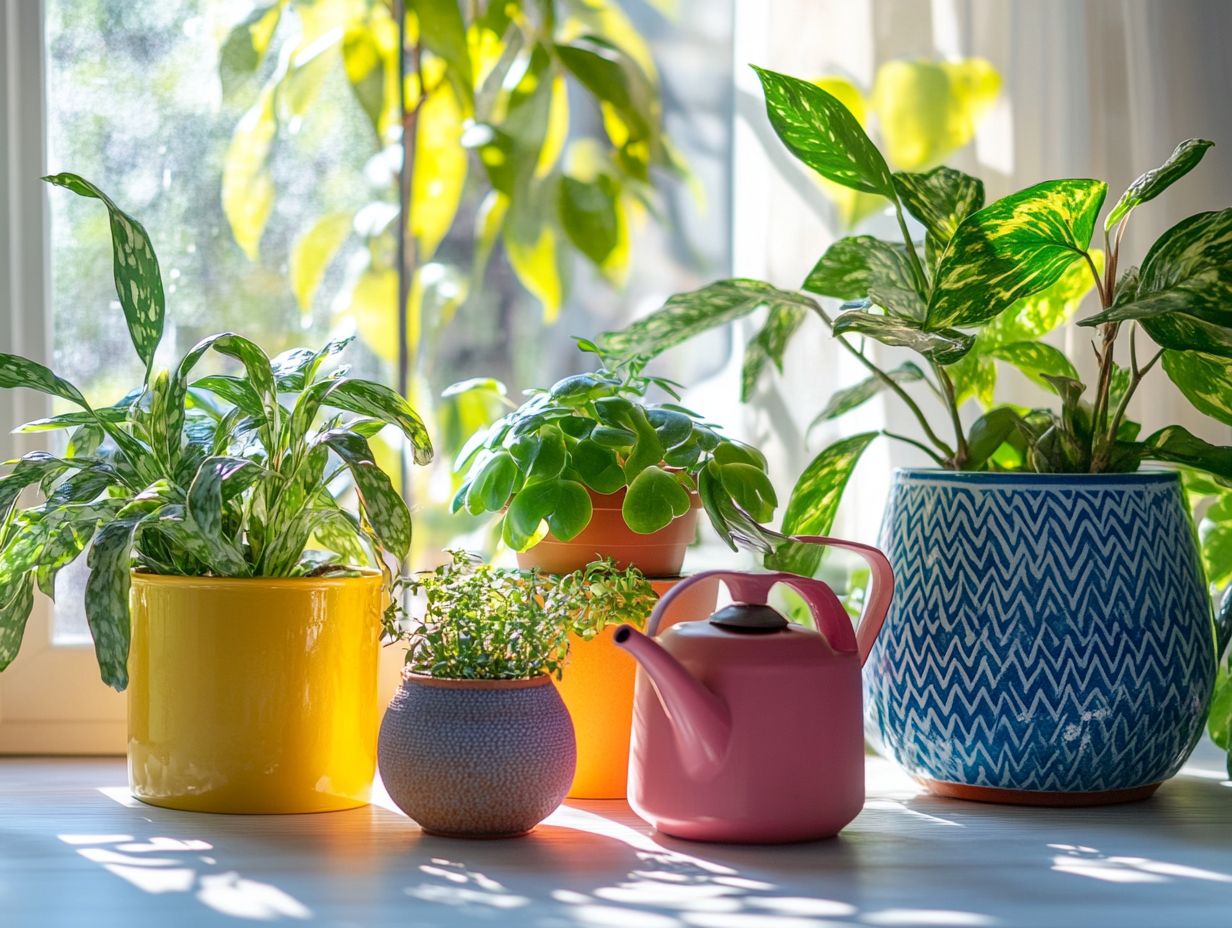
Don t miss out on keeping your plants healthy!
How often should I water my indoor plants?
Watering frequency varies by plant type, size, and environment. Check the soil moisture level before watering to avoid over or under watering.
Is it better to water indoor plants from the top or bottom?
Watering from the bottom isn t always the best choice. Some plants thrive with top watering, while others prefer the bottom. Researching your specific plant’s needs is essential.
Can I use ice cubes to water my indoor plants?
No, using ice cubes isn t a good idea. They can shock the roots and cause damage. Instead, use room temperature water!
Should I water my indoor plants with filtered water?
Using filtered water isn t necessary for most indoor plants. Regular tap water is usually safe and can provide beneficial minerals.
Do indoor plants need to be watered less in the winter?
Many think plants need less water in winter, but that’s a misconception. The dry air from heaters can actually dry out plants faster, so monitor their moisture and water as needed.
Can I water my indoor plants with leftover coffee or tea?
No, using coffee or tea isn t recommended. These drinks can harm plants and alter the soil s pH level. Stick to plain water for the best results!

